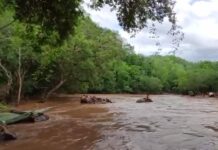By Kantarawaddy Times
In the wake of extensive flooding across Karenni State in Septembe, residents and internally displaced persons (IDPs)in Somo-Pray-Soe-Lay (also known as Shan Daw) Township are facing difficulties in accessing food supplies, relying on a multi-stage transport system involving both land and water routes.
“We have to load the goods onto trucks from Loikaw. From there, we transfer them onto boats to cross the flooded areas. Once they reach the other side, they are loaded onto trucks again for the final leg to the villages. Because the goods must be transported in stages, there are times when we run out of certain essential supplies,” explained a local woman regarding the complex transportation process.
Food and essential supplies for both IDPs and local residents must be transported through a combination of land and water routes. Due to the difficulty of the journey, transportation costs are high, leading to price increases for basic food items and occasional shortages.
The raining season has worsened road conditions, making it harder for IDPs and local residents in the mountainous areas to access staples such as rice, oil, and salt. In addition to the poor roads, the main routes into Somo-Pray-Soe-Lay (Shan Daw) Township have been blocked, further contributing to the scarcity of essential goods and supplies.
“Households that typically purchase rice and oil are now facing significant challenges. With the roads blocked and the flooding, transporting food supplies has become much harder,” said a displaced woman from the area.
The transportation route is a critical lifeline for displaced persons and flood-affected communities in eastern Loikaw. However, due to both the ongoing military conflict and the September floods, food deliveries to areas east of Loikaw have been severely disrupted, leading to substantial shortages.
Residents of Shan Daw Township primarily rely on sesame farming for their livelihoods, with the income used to support household expenses. Unfortunately, nearly 1,000 acres of sesame fields were destroyed in the flooding, raising serious concerns about long-term food security and economic hardship for the community.




